The small bodies of the Solar System (asteroids and comets) are the leftovers of the planetesimals that once formed the planets. As they trace the origin and collisional history of our Solar System, they can
provide key answers to fundamental questions regarding the formation and evolution of planetary systems and ultimately to the apparition of life as we know it. One simple case is the possible existence of the Planet IX, which is hypothesized based on the currently known trans-Neptunian planetoids (Batygin & Brown, 2016). Despite all the efforts to discover it, the current surveys can’t give a good answer regarding its existence because of the telescopes’ detection limit.
Furthermore, as of today we know two objects coming from the interstellar space, the asteroid 1I/’Oumuamua and the comet 2I/Borisov (e.g. ‘Oumuamua ISSI Team, 2019; de León et al., 2019). It is
expected that these kind of objects are passing at constant rate through our Solar System and they could be found as the detection methods improve.
A particular class of small bodies has practical importance, those that come close to the orbit of Earth. These are called the near Earth Objects (NEOs). At geologic time scales, these small bodies represent a potential threat to the life on our planet. This fact is evidenced by past impact events such as recent super-bolides, known craters and mass extinctions attributed to major impacts. There are at least 190 known Earth craters caused by asteroids or comets, while, on average, every year one meteoroid of about 3-4 m explodes in the atmosphere of our planet. Such a dramatic event happened on 15 Feb 2013, above the very populated city of Chelyabinsk (Russia), when a 20 meter super-bolide produced a 500 kT TNT explosion in the atmosphere, the shockwave injuring 1200 people (Popova et al., 2013). Another powerful 10 MT TNT explosion happened in 1908 in Tunguska (Siberia), when probably a comet, less than 100m, burned millions of trees over 2000 km2 , turning houses, animals and people to the ground (Chyba et al. 1993).
Last but not the least, 60 million years ago, the leading theory is that a large 10 km asteroid struck the Earth close to Chicxulub (Yucatan, Mexico), producing a 50 MT TNT explosion, causing the extinction of dinosaurs (Alvarez et al. 1980, Hildebrand et al., 1991). The critical element to enable the mitigation measures is the detection of these bodies with sufficient time in advance. This was proven by the exercise
performed during Planetary Defense Conference 2021 which considered a hypothetical threat of an asteroid.
On the the other hand, the NEOs are the key elements for the space exploration, which is is the new adventure for man-kind. At the time of this writing, NASA OSIRIS-REx and JAXA Hayabusa2 missions are ending their primary missions at two primitive NEOs (Bennu and Ryugu) supposed to have carbon-bearing and organic rich compositions. These spacecraft continue to function and their extended missions are planned. The choice of new targets was constrained by the possible trajectories these missions can follow. The principal investigator of this proposal contributed alongside a Japanese and Spanish team to identify the best targets for JAXA Hayabusa2 extended mission. We performed observations with the 10.4 m Gran Telescopio Canarias for detecting and significantly decreasing the orbital uncertainty of 1998 KY26
(Fig.1 right). This asteroid was found at an apparent magnitude of 26, but this astrometry was critical for mission planning. It is another example which highlights the importance of asteroids discovery and follow up.
In addition, the primitive NEAs are considered ideal targets for the In-Situ Resource Utilization (ISRU) and could become a source of materials for space activities in the near future. The best targets are those that require a low delta-v budget (an estimate of the total change in velocity required for a space mission), thus being on an Earth-like orbit (Abell et al. 2015). These particular objects are not easy detectable because their orbit makes the observational windows short and rare.
Last but not least, the detection and follow up of space debris is imperative for the space industry. Since humankind started the conquest of space, it has littered the space with debris and now it pollutes the sky from the near atmosphere to the geostationary region. The size of this debris runs from a few millimeters to several centimeters. It represents the remnants of spacecraft explosions or collisions, non-operative satellites, rocket upper stages, etc. The estimates show that there are more than 108 objects with size larger than 1 mm and more than 105 objects larger than 1 cm. The impact of such debris with operative spacecraft or satellites could result in a dangerous or even dramatic situation. Thus, telescope monitoring of space debris is essential for maintenance and control strategies, as well as to assess mitigation procedures (e.g. Rossi & Valsecchi 2006; Celletti & Galeș 2014).
The facts above highlight that monitoring the sky and our nearby space is essential to learn about the origin of life, to know our immediate surroundings, and to prevent possible celestial impacts that could endanger mankind and other species. In this context, we started the development of an innovative tool consisting in a modular and extensible software suite to detect faint moving objects in the images acquired through telescopes. We refer to this suite as “Umbrella”; with an open-source library called “Umbrella2” at the core, on top of which we developed an open-source pipeline for automated blink (the
reference pipeline), an image processing pipeline (IPP) a desktop interface (ViaNearby) and a web-based
interface (Webrella). Our methods take advantage of advanced image processing methods in order to detect the moving sources in telescope observations, and succeeds to go at the limit of noise. The main concepts, the basic properties of the algorithms, and the first experiments are presented by the scientific article Stănescu & Văduvescu, 2021, Astronomy & Computing.
Classic asteroid surveys (including the Umbrella reference pipeline) use the traditional blinking detection technique which begins with sequences of a few consecutive images of the same area of the sky, taken with the same exposure parameters (exposure time, gain, etc.) in a short time interval (Fig.1, left). The raw images are processed and aligned using the stars in the field, so that any moving source (asteroid) appears to shift during the night. Assuming a linear motion in a short observed interval, most of the noise can be identified and rejected, then the targets validated and their measurements reported to the Minor Planet Center (MPC).
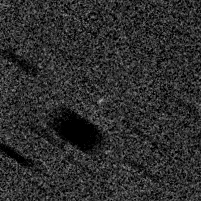
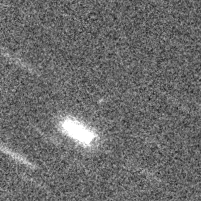
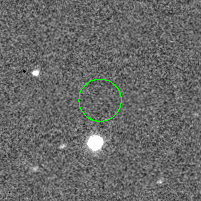
Fig. 1. (Left) The two NEAs discovered during the Nov 2018 pilot mini-survey using the 2.54 m Isaac Newton
Telescope (INT) with the traditional blinking method. The small inset combined track and stack image shows its recovery with a 0.3m aperture telescope from Cluj Napoca by amateur astronomer L. Hudin.
Source: Vaduvescu et al. 2021. (Right) The recovery of 1998 KY26 at an apparent magnitude of 26.4
(December 15, 2020), target of Hayabusa 2 extended mission, using 10.4 m Gran Telescopio Canarias.
Even larger telescopes can’t detect fainter or faster asteroids through the blink method, due to atmospheric turbulence and detector limitations. If a known object is invisible in the individual images, it is still possible to recover it through a technique called track-and-stack. In this case, more exposures are taken, which are shifted based on the predicted direction and speed of the target, then stacked to improve the signal to noise ratio, allowing the object to be detected with certainty in the co-added image (Fig. 1, right). We are experienced with this method, successfully recovering thousands of very faint one-opposition NEAs (e.g. Văduvescu et al. 2018).
This triggers another approach to the detection of unknown Solar System objects, it is called Synthetic Tracking, (also known as Digital Tracking). It was first suggested and used by a few North-American researchers to search for very faint Kuiper belt objects (KBOs) and trans-Neptunian objects
(TNOs) which move very slowly (Gladman & Kavelaars, 1997; Heinze et al. 2015). As suggested by the name, this method applies track-and-stack to „synthetic” motion vectors, that is all valid motion vectors, while scanning for detections. However, practical synthetic tracking algorithms operate differently from track-and-stack – the detection algorithm performs the stacking and it must identify automatically the unknown object, otherwise an impossible number of stacked image is required to be analyzed by human eye.
Moreover, the algorithms running on data-parallel hardware (GPU, FPGA), such as those mentioned in the next paragraphs, operate per-pixel (each lane in the arithmetic unit individually stacks/detects one pixel). With the exception of a few isolated cases (Yanagisawa et al. 2021), most of these Solar System objects have been found with the blink method; the main reason being that methods such as Synthetic Tracking require vastly more computational power to scan all possible object trajectories. This is particularly true for NEOs, since the apparent velocity of such objects is much higher than for other types of minor planets.
However, the blink method has several disadvantages compared to synthetic tracking, stemming from its brightness requirements. At modern discovery magnitudes, V > 21 mag, new objects can be discovered only with large telescopes. Furthermore, at these magnitudes, skyglow becomes an important hindrance. Even on dark nights (i.e. no Moon), for large telescopes or good cameras (and especially when both are combined), airglow becomes the largest source of noise (larger than the readout or dark current, see for example La Palma Technical Note 115 Night-Sky Brightness). Compound with the fact that faster asteroids streak across the image (thus covering more of the sky area with their PSF), the blink method yields diminishing returns in detection of faint objects (which are the most interesting both for scientific and practical purposes).
The newly discovered fainter asteroids must be followed-up in order to secure their orbits, but some of them and especially NEAs, quickly become invisible as they recede from Earth, being at risk to be lost due to insufficient observations to compute an accurate orbit. The follow up issue will become problematic in the future for the discoveries made by surveys performed with the large telescopes, such as the one that will be performed by Large Synoptic Survey Telescope (LSST) – Vera C. Rubin Observatory (Ivezić et al., 2019). Thus, advanced image processing methods (as those proposed in this project) are required in order to allow the small aperture telescopes (available to a large number of astronomers) to follow up these discoveries.
Fortunately, in such cases synthetic tracking comes to the rescue. However, applying synthetic tracking to fast moving objects soon becomes very computationally intensive for near real-time reduction of surveys. In 2005, the Japanese researcher T. Yanagisawa published an algorithm which applied for the first time synthetic tracking to the detection of NEAs and satellite space debris. In 2014-2015, a few North-American researchers (Shao et al. 2014; Zhai et al. 2014) performed several tests using synthetic trackingand sCMOS imaging cameras, demonstrating the feasibility to use this technique for discovery and improved astrometry using small telescopes located in average quality sites. Although their CPU (central processing unit) parallel processing algorithm proved very slow for fast moving objects, the team managed detected one unknown NEO during only one night. This object was extremely faint (magnitude V=23) and moved very fast (about 10 arcsec/min), being invisible in the individual images but standing clearly visible in the composite synthetic image.
As an alternative to classic CPU technology, Shao et al. 2014 mentioned the possible use of graphics processing units (GPU) in synthetic tracking experiments, but apparently this team has not published any result. In 2018, the computer scientist and amateur astronomer D. Parrott released the Tycho software2 which implements synthetic tracking detection using off-the-shelf video cards which proved much better results than traditional CPU. This Windows software depends on other software for previous image reduction, but the author proved the capability of synthetic tracking to discover or recover very faint asteroids (e.g. magnitude V~19 using a very small,13 cm aperture, telescope). Source code for Tycho is not publically available, however Whidden et al. 2019 published (including the CUDA code) a faster parallel algorithm (KBMOD) for searching through candidate asteroid trajectories that utilizes graphics processing units. Based on it, they found 39 previously unknown Kuiper belt objects (KBOs) in the 150 square degrees of a survey performed with the Dark Energy Camera (DECam) mounted 4 m Victor Blanco Telescope.
In the meantime, T. Yanagisawa ported the synthetic tracking algorithm to a Field Programmable Gate Array (FPGA). In a paper published this year (Yanagisawa et al. 2021), through the use of a far more powerful FPGA, the authors have achieved near real-time detection on small cameras. The same paper mentioned that during last three years, they discovered 10 NEAs using three very small 20-cm class telescopes, planning to implement this technology aboard small satellites of JAXA. Having reached the limits of the blink method with Umbrella in the EURONEAR surveys, (large observational programs dedicated to find NEOs using the 2.54m Isaac Newton Telescope equipped with the Wide Field Camera) we started the development a prototype of a synthetic tracking algorithm (STU, Synthetic Tracking on Umbrella), leveraging our versatile Umbrella2 library and the power of modern video cards. Preliminary results obtained while developing the prototype indicate that STU is much faster than Tycho (minutes instead of hours on EURONEAR surveys, even while searching more densely), and faster than the FPGA (Field Programmable Gate Arrays) implementation published by Yanagisawa et al. 2021 (despite using an older, and an order of magnitude cheaper GPU compared to their FPGA), while detecting objects under the noise level of individual images.
Through this project called Data-parallel detection of Solar System objects and space debris (acronym ParaSOL), we aim to bring the new modules of the Umbrella software suite, primarily the STU prototype, but also the IPP and Webrella, from a technology concept (Technology Readiness Level – TLR 2) to a software package with the critical functionality validated (TLR 4). We will do so by developing the prototype into a fully-fledged Umbrella pipeline. By leveraging the existing Umbrella code, it will then be available as an integrated software package and/or as a detection pipeline for the Webrella server, allowing efficient validation of its functionality.
The overall goal of our team is to create a dedicated platform and to apply it for the near-real time discovery, recovery and monitoring of NEAs, space debris, MBAs, using various small telescopes (such as those to which we have access in Romania or Tenerife/Spain), and for KBOs (Kuiper Belt Objects), TNOs (Trans Neptunian Objects) and other exotic objects (such as the interstellar ones) using medium and larger telescopes. Our tool could be also applied to archival data obtained by various observational programs such as all-sky survey.
Our proposed project falls into the category of hardware and software products and technologies with great potential for applications, both for science and for space industry. During these two years, the project will pass through two successive technology readiness levels, starting from TLR2 which will employ the published research to prove the feasibility, TLR3 and TLR4 which will develop the technology. Thus, in order to qualify the Umbrella software suite for TLR 4 the following objectives are required/targeted:
a) The implementation of synthetic tracking and trails detection modules into Umbrella software suite;
b) Validation of critical properties for all Umbrella modules;
c) The development of integrated platform for all our software components;
d) The implementation and testing of the algorithms by taking into account various computational architectures;
e) The performance evaluation in the relevant environment.
The critical functionality will be validated and the performances will be estimated by taking into account the following environments:
1) Recovery and follow-up of poorly observed MBAs and NEAs using small telescopes (20-60cm) available in Romania;
2) Discovery of asteroids using various small telescopes (<60 cm diam) available in Romania and Spain, and two medium-sized 2 – 4m telescopes to which we have access in La Palma, Canary Island (Spain);
3) Recovery and discovery of space debris;
4) Attempt to discovery of distant asteroids (KBOs and TNOs) using medium-sized 2-4m or large 8-10m telescopes in La Palma and Chile, to which we could gain access.
The main applications of our work are the surveys dedicated to discover and recover the small bodies of the Solar System and the space debris. These modern observational programmes take advantage of the CMOS devices which can read images 100 times faster than CCDs, thus one can use the dead time to acquire more images, which can increase the number of detections. These became very accessible to smaller research facilities, universities, and also to modest private citizen scientists willing to bring some contributions. Moreover, some old 1-m class existing telescopes in great sites are dormant or under-subscribed, and they could be involved in digital tracking surveys. Very small telescopes (20-40 cm) are affordable and easy to deploy as arrays which could cover sky areas much larger than one large and much
more expensive telescope (and therefore impossible to dedicate to survey work), thus small telescopes have new opportunities, thanks to increased computing power at low cost, backed by applications such as the present one. As a particular case, our software product will be very useful to institutions, private companies and amateur astronomers (including students and future professional astronomers) without access to large aperture telescopes, but interested in discovery and follow up of asteroids and space debris.
The proposed platform can become a very powerful tool not only for survey work, but also to derive very accurate astrometric positions and distances of various Solar System objects. The STU module will be one of the few digital tracking detectors in the world , and to our knowledge, the first in Europe (we are aware only of those presented above). It will include unique capabilities in terms of speed, detection efficiency, and the possibility to handle large mosaic cameras. Thus, it can represent a key element for the design for implementing groundbreaking surveys. The aim to contribute with outstanding results is not utopic, as proved for example by the recent discovery of the first extra-solar comet 2I/Borisov (missed for months by major professional surveys) by the amateur astronomer G. Borisov using his home built 65-cm telescope.
At local level, our tool can be used by small Romanian teams (universities, research institutes, colleges, astronomy clubs, planetaria) and also by private amateurs in a Romanian network aiming to run NEA surveys capable of bringing European contributions to Solar System research. Thus, it will strength the
existing collaborations and it will create new ones. At international level, we already identified several 1-2m class under-subscribed telescopes located in good astronomical observatories in Europe and Chile, which we plan to use in a project for NEO and space debris surveys using this software suite. Moreover, we will apply for regular observing time using larger 4-8m telescopes for mini-surveys focused on other closely
Concept of technology / product
This project builds upon the expertise of the team in the Solar System science and on space exploration. It is made in the framework of the principal investigator’s previous projects, “Compositional mapping of asteroid population based on spectral and spectrophotometric data”, and “Big Data for Small Bodies”. Both of them received funding (totaling ~210 000 euro) through the Young Research Team programs of Romanian National Authority for Scientific Research and Innovation, CNCS – UEFISCDI.
Through the current proposal we aim to convert the ideas and concepts developed during previous projects into practical applications for space science and industry.
The team behind this proposal has wide experience with various telescopes and methods to discover, recover, precover and follow up thousands of NEOs and their subclass of potentially hazardous asteroids and virtual impactors (e.g. Vaduvescu et al. 2011; Vaduvescu, Popescu et al. 2013; Vaduvescu et al. 2015; Popescu et al. 2016; Vaduvescu et al. 2018; Vaduvescu, Curelaru, Popescu 2020, Stănescu &Văduvescu 2021). We were among the first to use the data-mining for astrometric measurements and to significantly decrease the orbital uncertainty of more than 2000 near-Earth asteroids (NEAs).
The current proposal starts with the existing Umbrella software suite, described by Stănescu & Văduvescu 2021, Astronomy and Computing. This article describes the concepts and the basic properties of the algorithms. The first experiments for the discovery and recovery of some bright asteroids were performed using data analyzed with other existing tools such as Astrometrica and the NEARBY platform.
These tools requires multiple inputs and guiding provided by a human, thus, they are making the work slow and not optimal for analyzing large fields.
The existing core library of our software provides all the necessary datatypes, functions and algorithms for creating a fully-fledged blink pipeline. This ranges from image reading and writing (FITS –Flexible Image Transport System, version 3.0 is built-in, but other formats, such as ASDF, can be implemented without changes to the core library), to functions querying external Virtual Observatory tools (SkyBoT, described by Berthier et al. 2006). A cornerstone of our library is the algorithms framework, which enables users to implement new algorithms just by writing the function as a kernel (directly performing the operation on pixel data), while the library handles reading (and writing where necessary) the image data, as well as scheduling the function across multiple threads in parallel.
The library also includes well-known de-noising methods (weighted mean, median and two kinds of trimmed mean averaging), image conditioning such as background normalization/flattening, and star masking. In terms of detection algorithms, Umbrella2 provides a blob algorithm (which is a connected component algorithm with a hysteresis threshold), and a trail detection algorithm based on the Auxiliary
Feature Augmented Voting Hough Transform (a method also discovered by the main developer), as well
as support for importing detections from Source Extractor catalogs. For combining detections from individual images, Umbrella2 provides two pairing algorithm; the newer one based on fitting a straight line through the detections and measuring the deviation (RMS) of the detections from the fitted trajectory.
Finally, filters carefully designed over the lifetime of the project remove almost all false positives (unless the input image has had badpixels incorrectly reduced or the detection thresholds are set very low) — a list of typical false positives, 90% of which is covered by our filters, can be found in Waszczak et al. 2017.
The detections reported by now through Umbrella have been obtained by our team through the “reference pipeline”, a multi-stage blink pipeline, which makes extensive use of the de-noising and image conditioning operations, as well as the detection and tracklet (object candidate) filters. Another distinctive feature of our pipeline is the last step of an extensive lookup to recover objects that have been detected on the conditioned images back on the original, input images. By performing the last step for each
detection on all images and with a lower threshold, it is possible to remove some false positives of stellar or badpixel origin and that could not be removed by the image conditioning stages without compromising true positives (real detections). This pipeline is also designed as a library, which is used by the interactive components of the Umbrella software suite. To provide a convenient method for users to run the blink pipeline, the team developed a desktop application with a graphical user interface. The GUI is designed for quick and accurate validation of the detections, starting from automatic recognition of fields not yet run to detection parameters view and hotkey navigation in the tracklet validation form.
Finally, to allow reducers to use Umbrella without needing of owning a powerful desktop computer, a web application (Webrella) that can be deployed as a web server has been developed. It allows users to create surveys and load pipeline configurations for them, load images and run them through the reference pipeline with any of the loaded configurations, and then validate the detections from the pipeline through a dedicated page. The pipeline is called on the server as a separate process, and all results are stored on-disk, from which Webrella reads them.Since the article publication (Stănescu and
Văduvescu 2021), Umbrella has also gained an image processing pipeline (IPP), for processing raw camera data into plate-solved images ready to use with detection pipelines. It combines the bias, dark and flat images into master images, as well as reduce the raw science images with said master images (Fig. 2). Plate solving is done through the external AstrOmatic suite3 , the IPP calling Source Extractor, SCAMP and SWarp to obtain the final images.
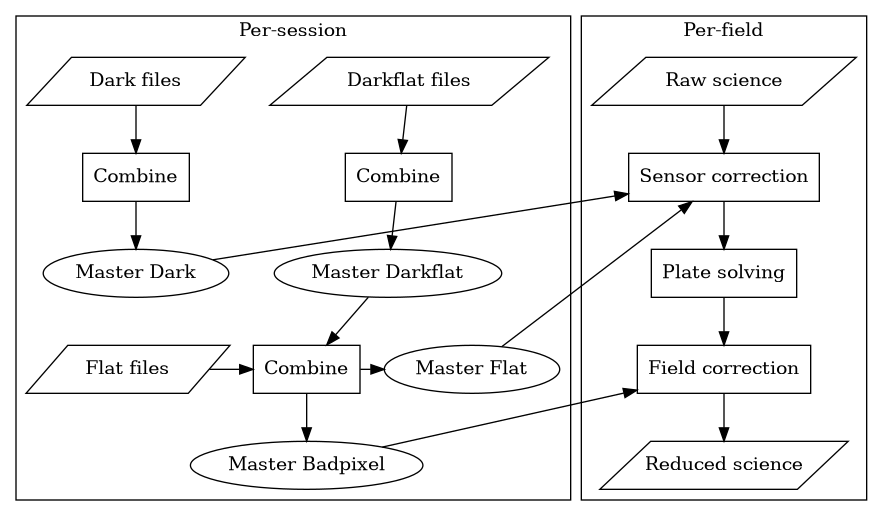
We started the development of STU (Synthetic Tracking on Umbrella – the most powerful tool that our software suite proposes), a prototype Synthetic Tracking pipeline, which levrages the Umbrella2 library for existing functionality and OpenCL to tap into the power of modern GPUs. As a pipeline (Fig. 2), STU will begin with some image conditioning tasks, such as star masking (median stacking and star detection/mask generation through Umbrella2, handled on the CPU, masking the original images done through OpenCL, on the GPU). This will be followed by re-projecting the input images into a common gnomonic projection chart (so that asteroids move in straight lines in X-Y coordinates), directly on the GPU.
The data cube will be then processed in “scan stage”, which is the actual GPU-based search. The search algorithm will use a combination of threshold counting (a generalization of thresholding the median value and very robust to false positives), with the more common addition for refining the results (since computing the median is expensive).
Our initial tests show that unlike previously published implementations (such as KBMOD), our algorithm is cache-friendly, overcoming the Video RAM bottleneck for additional speed. Moreover, by using the middle of the stack as the starting point for stacking, we only require 1/4 of the vectors at the same granularity bound. Finally, in cases where a sufficiently large number (>24) of exposures is available (the typical case for synthetic tracking), the algorithm can bail early for a vector if the brightness is not sufficient in the first 1/3 of the images. At the same granularity, the speedup can reach a factor of 27. We are not aware of any other synthetic tracking implementation that makes use of these or similar techniques.
The results from –the scan stage will be matched into detections combining multiple pixels (merging stage) and then will be stacked with median averaging on the GPU in order to robustly obtain the precise motion vector of the detection. The results are dumped on disk, in form of track-and-stack images of the detection, the position and motion vector of the detection, and the positions of the object in the Minor Planet Center optical record format. We performed several preliminary experiments with the concept of STU module. The result highlighted in Fig. 3 represents a proof of concept. We used some images obtained by our team in a survey dedicated to find new asteroids using the traditional blinking method in Astrometrica (an approach we used for years, which is widely used across the world) and NEARBY platform.
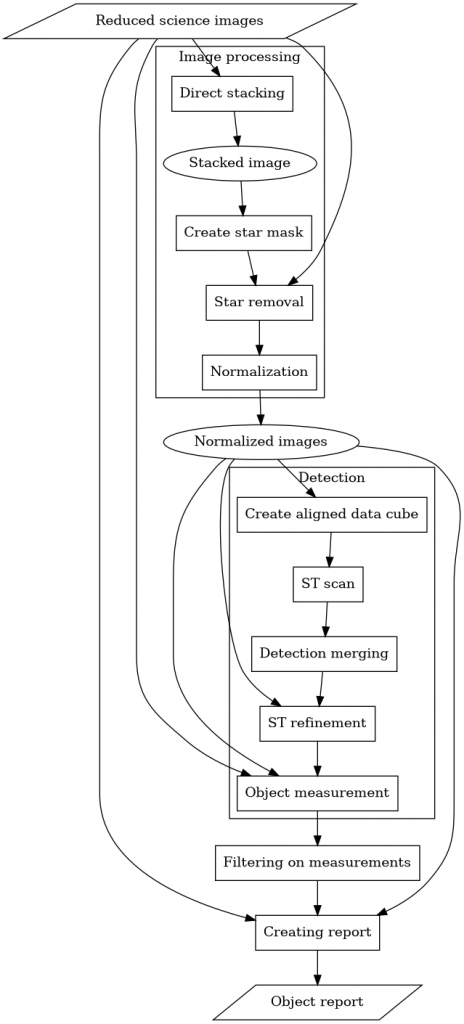
An example of unknown object of 22.5 apparent magnitude identified on images acquired with INT telescope. Left – the object is unidentifiable (bellow the noise limit) in individual images acquired with 30 sec exposure time (thus, the object will not be found with the classic blinking method), middle – the object can be seen after applying STU over 30 images, right – the object is automatically detect after masking the fixed sources (stars, galaxies …). Its apparent motion had the values mu_RA -0.41″/min, mu_Dec -0.26″/min which suggest a main belt object.
The team in this proposal collaborates for more than seven years on various topics related to small bodies of the Solar System. Based on our past experimental projects EURONEAR and NEARBY we have extensive experience in image reduction under in Python using IRAF/PyRAF and the SExtractor suite and in development using the C# and Open CL languages. We have used images in the standard FITS format
acquired either from new observations (15 telescopes) or data mining of existing image archives (7 telescopes). The results were published in seven ISI papers (2005-2020) with a first author from our group. The results were also presented at nine international conferences.